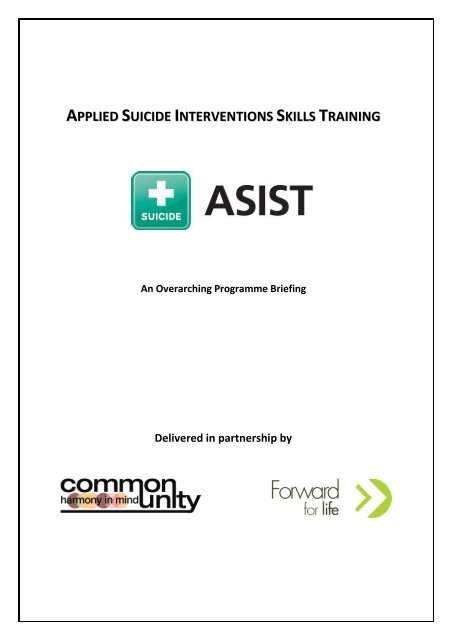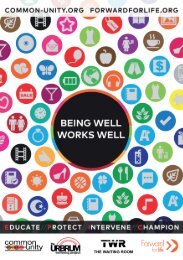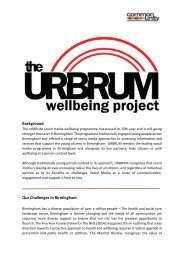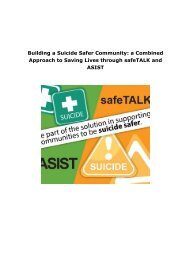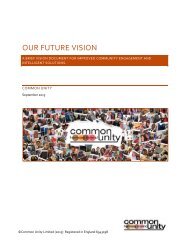Programme_Briefing_-Asist_CU_FFL_CRight
You also want an ePaper? Increase the reach of your titles
YUMPU automatically turns print PDFs into web optimized ePapers that Google loves.
APPLIED SUICIDE INTERVENTIONS SKILLS TRAINING<br />
An Overarching <strong>Programme</strong> <strong>Briefing</strong><br />
Delivered in partnership by
27 th January 2013<br />
© Forward For Life Limited; Common Unity Limited<br />
THE PARTNERSHIP<br />
Common Unity Social Enterprise is a Health and Social Care organisation specialising in working<br />
on mental health and wellbeing with ‘hard to reach’ communities. It was established in 2009 by<br />
community activists from BME communities who were also mental health professionals, and who<br />
had grown up in the inner city areas of the West Midlands.<br />
Their personal and professional experiences have formed their instincts about, and specific<br />
insights into, what works in communication with a wide range of audiences. They help<br />
individuals, communities and service providers to overcome barriers to communication and the<br />
fulfilment of potential, ensuring that services are both accessible and relevant.<br />
e: caront@common-unity.com m: 07990 947 093<br />
Website: www.common-unity.com<br />
Forward For Life through its programmes of work looks to provide benefit to communities where<br />
marked inequalities in health status are most apparent being recognised as related to social and<br />
economic inequalities in society<br />
Established with recognised professional expertise in the areas of the wider public well-being<br />
agenda, health and well-being service redesign, mental health promotion, suicide prevention,<br />
procurement, commissioning and person centred training design and facilitation, Forward For<br />
Life supports the health and social care sector and other associated stakeholders to realise a<br />
positive impact on the health and well-being of communities.<br />
e: terry.rigby@forwardforlife.org m: 07585 776 800<br />
Website: www.forwardforlife.org<br />
COMMON UNITY AND FORWARD FOR LIFE ARE CERTIFIED ASIST TRAINERS
27 th January 2013<br />
© Forward For Life Limited; Common Unity Limited<br />
THE CHALLENGE<br />
Suicide is a major issue at an international level with there being direct relationships realised<br />
between Suicide numbers and health, social and economic inequalities. In England, one person<br />
dies every two hours as a result of suicide. When someone takes their own life, the effect on<br />
their family and friends is devastating. Many others involved in providing support and care will<br />
feel the impact.<br />
The suicide rate in the U.K. drastically shot up in 2011, reaching an all-time high since 2004,<br />
according to the latest data from the Office for National Statistics. The 8% increase in the<br />
number of suicides from 2010 to 2011 highlights the effects that times of financial hardship can<br />
have on the public.<br />
In total, there were 6,045 suicides in 2011 which is 437 more than the previous year, translating<br />
into a rise from 11.1 to 11.8 deaths per 100,000 people. The number of male suicides increased<br />
in 2011 to 4,552, a rate of 18.2 per 100,000 (the highest it's been in 10 years). Female suicides<br />
also increased to 1,493, a rate of 5.6 per 100,000 (the highest rate in 6 years).<br />
The suicide rate was highest among men in their late 30s and early 40s (23.5 deaths per 100,000<br />
population in 2011). Suicide is the second biggest killer among young men globally. A recent<br />
study published in The Lancet found that there is a serious lack of research into what prevention<br />
techniques are the most effective in preventing suicide.<br />
Preventing suicide in England: A cross-government outcomes strategy to save lives (2012) i states<br />
“there are direct links between mental ill health and social factors such as unemployment and<br />
debt. Both are risk factors for suicide. Previous periods of high unemployment and/or severe<br />
economic problems have been accompanied by increased incidence of mental ill health and<br />
higher suicide rates.”<br />
A recent British Medical Journal Study ii<br />
(published August 2012) showed clear<br />
evidence linking the recent increase in<br />
suicides in England with the financial crisis<br />
that began in 2008 for both men and women.<br />
English regions with the largest rises in<br />
unemployment have had the largest increases<br />
in suicides, particularly among men. Recent<br />
figures for the West Midlands showed that<br />
suicide rates have increased by 24 per cent,<br />
with 2007 data recording 245 deaths by<br />
suicide/undetermined deaths and the 2010<br />
data showing the number of recorded deaths<br />
being recorded as 450.
27 th January 2013<br />
© Forward For Life Limited; Common Unity Limited<br />
The Preventing suicide in England: A cross-government outcomes strategy to save lives (2012)<br />
recognises the value of high quality training and development in a bid to reduce suicide rates stating<br />
that interventions that raise suicide awareness or training programmes that teach people how to<br />
recognise and respond to the warning signs for suicide in themselves or in others are effective being<br />
delivered in a variety of settings including schools, colleges, workplaces and community settings.
27 th January 2013<br />
© Forward For Life Limited; Common Unity Limited<br />
THE CONTEXT, THE FACTS & SERVICE AREAS<br />
There are a number of key vulnerable groups that must be engaged either directly or through<br />
specific service sectors to realise a reduction in suicide rates – below is an outline of potential<br />
support service areas and vulnerable groups:<br />
1) Primary Care Services -<br />
GPs can make a big difference to overall suicide rates. General practices will see a lot of<br />
people with many of the known factors for higher risk of suicide, for example long-term<br />
physical health problems, self-harming, drug and alcohol misuse and mental health<br />
problems. They are the first point of contact for many people who are experiencing distress<br />
or suicidal thoughts and who may be vulnerable to suicide. GPs are also the key gatekeepers<br />
to specialist services.<br />
Primary care staff may also be the first point of contact for people who are bereaved or<br />
affected by the suicide of family members, friends and colleagues.<br />
Health visitors, midwives and other community staff may be in contact with children, young<br />
people and families and be the first to be aware of mental health problems or other<br />
difficulties developing. They can therefore provide direct support and also refer speedily to<br />
other services.<br />
2) Veterinary Surgeons iii<br />
There is an increasing body of research to suggest that veterinary surgeons are significantly<br />
more likely to die by suicide than those in other healthcare professions and the general<br />
population.<br />
3) Farming Community iv<br />
It has been suggested that the high risk of suicide in farmers may be related to their ease of<br />
access to dangerous means of suicide. Farmers who commit suicide tend to use methods to<br />
which they have easy access.<br />
4) Female Nurses<br />
There is evidence v from several countries that female nurses are at increased risk of suicide.<br />
Very little information is available about the specific causes. Increased risk in nurses has been<br />
statistically associated with smoking and negatively related to extent of caffeine<br />
consumption. Unlike some other high-risk occupational groups, it is unclear to what extent<br />
access to means for suicide contributes to nurses' risk<br />
5) Education Sector vi<br />
Suicide consistently ranks as one of the leading causes of death for adolescents between 15<br />
and 19 years of age. Suicide accounts for 30% of deaths in the 15-24 year age group (Carr,<br />
2002). There has been an increase in suicide mortality and morbidity over most of the 20th<br />
century among white adolescents in the US and Europe.
27 th January 2013<br />
© Forward For Life Limited; Common Unity Limited<br />
Research from around the world has consistently indicated that suicide and suicide attempts<br />
in young people are complex behaviours with multiple causes. Studies of youthful suicidal<br />
behaviour consistently report that many young people who die by suicide or who make<br />
serious suicide attempts have a recognisable psychiatric disorder at the time of their attempt,<br />
such as depression, anxiety, conduct disorders and substance misuse.<br />
6) Older People vii<br />
Each year across the world, 1 million people take their own lives; in the United Kingdom<br />
about 5000 people, many of them over 65 years. In fact, older people are the most successful<br />
age group for suicide with about one in four attempts resulting in death. Around two thirds<br />
of these suffered from depression and with timely detection and intervention their deaths<br />
could have been prevented. Evidence shows that suicide in older people is reasonably well<br />
understood; it results from complex social, psychological, biological and spiritual processes.<br />
7) Acute Care Sector viii<br />
There is a very strong relationship between deliberate self harm (DSH) and suicide in that<br />
between 40% and 60% of people who die by suicide have a history of at least one episode of<br />
DSH, and DSH is the strongest risk factor for suicide. Up-to-date information on risk of suicide<br />
following DSH is required in order to both target and evaluate suicide prevention initiatives.<br />
In recent years in the United Kingdom there have been increases in the extent of DSH. Also,<br />
the age, gender and characteristics of both DSH patients and people dying by suicide have<br />
changed, with increasing rates in young males.<br />
8) Prisons ix<br />
People in prison are unusually susceptible to self-harm and suicide. Male prisoners are five<br />
times more likely than men in the general public to die by suicide, while the rate among<br />
young offenders is 18 times higher (Fazel et al, 2005). Self-harming behaviour is also<br />
widespread in prisons, the rates for both genders being higher than in the general<br />
population.<br />
9) Police Services<br />
Although it is recognised that many individuals with thoughts of suicide make contact with<br />
their GP’s in the 3 months prior to taking their own life, studies have shown that police have<br />
an even higher contact ratio by the very nature of their job compared to both GP’s and<br />
accident and emergency – one such study was undertaken in County Durham and Darlington<br />
in 2007 x . In this study a total of 133 suicide verdicts were recorded in a 3-year period; 43<br />
open and 29 accidental death verdicts were included as ‘probable’ suicides. This gave a total<br />
of 205 probable suicides within the 3-year period.<br />
Twenty-four individuals (12%) had had contact with the police within 3 months of death as<br />
victims of crime and 24 individuals (12%) had been arrested as alleged perpetrators of crime.<br />
Seven individuals had been both a victim of crime and an alleged perpetrator in the 3-month<br />
period, leaving an actual total of 41 people (20%) who had been in contact with the police.
27 th January 2013<br />
© Forward For Life Limited; Common Unity Limited<br />
10) Armed Forces xi<br />
The rate of suicide among those serving in the UK Armed Forces has been reported to be<br />
lower than that in the general population and this is likely to reflect a “healthy worker effect”<br />
(the phenomenon of lower morbidity or mortality in certain occupational groups compared<br />
to the general population because those with severe illness or disability are less likely to be<br />
employed in those occupations). A number of studies have examined suicide outcomes in<br />
relation to recent conflicts. For example, in the UK, researchers found no differences in<br />
suicide mortality between those deployed to the 1990–1991 Gulf War and a matched cohort<br />
of individuals who were serving in the Armed Forces but were not deployed.<br />
However, Young men leaving the British armed forces are up to three times more likely to kill<br />
themselves than their civilian counterparts, according to a study funded by the Ministry of<br />
Defence.<br />
Researchers at the University of Manchester compared UK military discharge records from<br />
1996 to 2005 with national suicide statistics and found that, while the overall suicide rate<br />
among ex-military personnel was similar to that of the general population, veterans aged<br />
under 24 were at high risk; In fact, they were two to three times more likely to kill<br />
themselves than civilian men of the same age. Suicide was most likely within the first two<br />
years after discharge, the analysis by the university's centre for suicide prevention found. The<br />
risk of suicide was also higher in young women aged under 20 compared with the general<br />
population<br />
11) Men xii<br />
Masculinities<br />
Masculinity is associated with control, but when men are depressed or in crisis, they can feel<br />
out of control. This can propel some men towards suicidal behaviour as a way of regaining<br />
control. Men are more likely to use drugs or alcohol in response to distress.<br />
Relationship breakdown<br />
Relationship breakdown is more likely to lead men, rather than women, to suicide. Men rely<br />
more on their partners for emotional support and suffer this loss more acutely. Men are<br />
more likely to be separated from their children and this plays a role in some men’s suicides.<br />
Emotional lives and social disconnectedness<br />
The way men are taught, through childhood, to be ‘manly’ does not emphasise social and<br />
emotional skills. Men can experience a ‘big build’ of distress, which can culminate in crisis.<br />
Men in mid-life are dependent primarily on female partners for emotional support. Women<br />
maintain close same-sex relationships across their lives, but men’s peer relationships drop<br />
away after the age of 30. Women are much more open to talking about emotions than men<br />
of all ages and social classes. Men are much less likely than women to have a positive view of<br />
counselling or therapy. However, both men and women make use of these services at times<br />
of crisis.
27 th January 2013<br />
© Forward For Life Limited; Common Unity Limited<br />
Men in their mid-years today<br />
Men currently in their mid-years are the ‘buffer’ generation – caught between the traditional<br />
silent, strong, austere masculinity of their fathers and the more progressive, open and<br />
individualistic generation of their sons. They do not know which of these ways of life and<br />
masculine cultures to follow. In addition, since the 1970s, several social changes have<br />
impacted on personal lives, including rising female employment, increased partnering and<br />
de-partnering and solo-living. As a result, men in mid-life are increasingly likely to be living on<br />
their own, with little or no experience of coping emotionally or seeking help on their own,<br />
and few supportive relationships to fall back on.<br />
12) Socio-Economics<br />
There are systematic socio-economic inequalities in suicide risk.<br />
Socio-economic position can be defined in many ways – by job, class, education, income, or<br />
housing.<br />
Whichever indicator is used, people in the lower positions are at higher risk of suicide. As you<br />
go down each rung of the social ladder, the risk of suicide increases, even after taking into<br />
account underlying mental health problems. There is debate over precisely how low social<br />
position increases suicide risk. Suggestions include having many more adverse experiences,<br />
powerlessness, stigma and disrespect, social exclusion, poor mental health and unhealthy<br />
lifestyles.
27 th January 2013<br />
© Forward For Life Limited; Common Unity Limited<br />
WHAT IS ASIST?<br />
Applied Suicide Intervention Skills Training (ASIST) trains frontline staff in early intervention. The 14-<br />
hour workshop held over two days teaches participants to connect, understand and assist people<br />
who may be at risk of suicide.<br />
The intervention is intended to prevent suicidal thoughts becoming suicidal behaviours. ASIST is<br />
underpinned by the idea that many people who are thinking about suicide will find some way to<br />
signal their intent. The workshops provide training in suicide intervention and are designed to help a<br />
person become more ready, willing, and able to help someone who is having thoughts of suicide.<br />
ASIST is intensive, interactive and practice dominated to help caregivers — or any people of trust —<br />
recognise risk and learn how to intervene to prevent the immediate risk of suicide.<br />
It is suitable for mental health professionals, nurses, doctors, pharmacists, teachers, counsellors,<br />
youth workers, police and prison staff, school support staff, clergy, community volunteers, and those<br />
training to undertake these roles.<br />
ASIST provides standardised, quality assured training that establishes a common language for<br />
referrals and is building a network across the UK. This promotes the sharing of peer experiences<br />
regionally and nationally. Creating a common language between organisations and community is key<br />
to ensuring support, both for people experiencing suicidal thoughts and for those assisting them.<br />
ASIST aims to help create clear and lasting community and inter-organisational pathways and<br />
networks for understanding and communicating suicide risk and appropriate solutions to preventing<br />
it.<br />
WHY ASIST?<br />
Evaluations of ASIST have shown that it is popular with participants and results in changes in<br />
knowledge, attitudes and skills. It has also been shown to have an impact in intervention behaviour.<br />
The impact of ASIST on suicidal behaviour has not been evaluated. To assess its impact on national<br />
suicide rates would require an extremely large study population. Even if this could be achieved it is<br />
widely recognised that the cause of suicide is multi determined and includes complex psychological,<br />
sociological and biological factors. It would be difficult to attribute any change in rates to one<br />
intervention.
27 th January 2013<br />
© Forward For Life Limited; Common Unity Limited<br />
ASIST has been implemented in Scotland xiii and an evaluation of its use and impact there, based on<br />
an internet survey with 534 respondents, concluded that it had been successful in raising awareness<br />
of suicide and increasing the body of people with intervention skills<br />
ASIST has been recognised within the most recent evaluation undertaken in Wales xiv that “the rollout<br />
of ASIST the project is making a positive contribution towards suicide prevention within Wales. It<br />
is raising awareness and creating a greater understanding and acceptance that prevention of suicide<br />
is everybody’s business.”<br />
ASIST was developed by LivingWorks in Calgary, Canada, in the early 1980s and since then over one<br />
million people in 22 countries have been trained.
27 th January 2013<br />
© Forward For Life Limited; Common Unity Limited<br />
Bibliography and Citations<br />
i http://www.dh.gov.uk/health/2012/09/suicide-prevention/<br />
ii BMJ 2012;345:e5142<br />
iii<br />
Platt, B., Hawton, K., Simkin, S. & Mellanby, R. J. (2012). Suicidal behaviour and psychosocial<br />
problems in veterinary surgeons: a systematic review. Social Psychiatry and Psychiatric<br />
Epidemiology, 47, 223-240. doi:10.1007/s00127-010-0328-6<br />
iv<br />
Kelly S, Charlton J, Jenkins R (1995) Suicide deaths in England and Wales, 1982–92: The<br />
contribution of occupation and geography. Popul Trends 80:16–25<br />
v Hawton, K., Vislisel, L. (1999) Suicide in nurses. Suicide and Life-Threatening Behavior, 29, 86-95<br />
vi<br />
Evans, E., Hawton, K., Rodham, K., Deeks, J. (2005) The prevalence of suicidal phenomena in<br />
adolescents: a systematic review of population-based studies. Suicide and Life-Threatening Behavior,<br />
35, 239-250.<br />
vii<br />
http://www.guardian.co.uk/society/2012/jul/15/suicide-rise-older-men<br />
viii Injury Hospitalization and Risks for Subsequent Self-Injury and Suicide: A National Study From New<br />
Zealand<br />
ix Fazel, S., Cartwright, J., Norman-Nott, A., Hawton, K. (2008) Suicide in prisoners: a systematic<br />
review of risk factors. Journal of Clinical Psychiatry, 69, 1721-1731<br />
x http://bjp.rcpsych.org/content/190/2/170.full<br />
xi Kapur N, While D, Blatchley N, Bray I, Harrison K (2009) Suicide after Leaving the UK Armed Forces<br />
—A Cohort Study. PLoS Med 6(3): e1000026. doi:10.1371/journal.pmed.1000026<br />
xii<br />
Section on Men and Socio-Economics owes much reference to Men, Suicide and Society : Why<br />
Disadvantaged Men in Mid-Life Die by Suicide” (2012) Samaritans Research Report<br />
xiii Griesbach D et al. (2008), The use and impact of Applied Suicide Intervention Skills Training (ASIST)<br />
in Scotland: An evaluation, Edinburgh, Scottish Government Social Research<br />
xiv Price, S. et al (2012) Positive Choices: Helping To Prevent Suicide Across Wales, Mind, Cymru<br />
Common-Unity Limited - Registered in England number 6943198<br />
Forward For Life Limited, registered in England number 8301193


